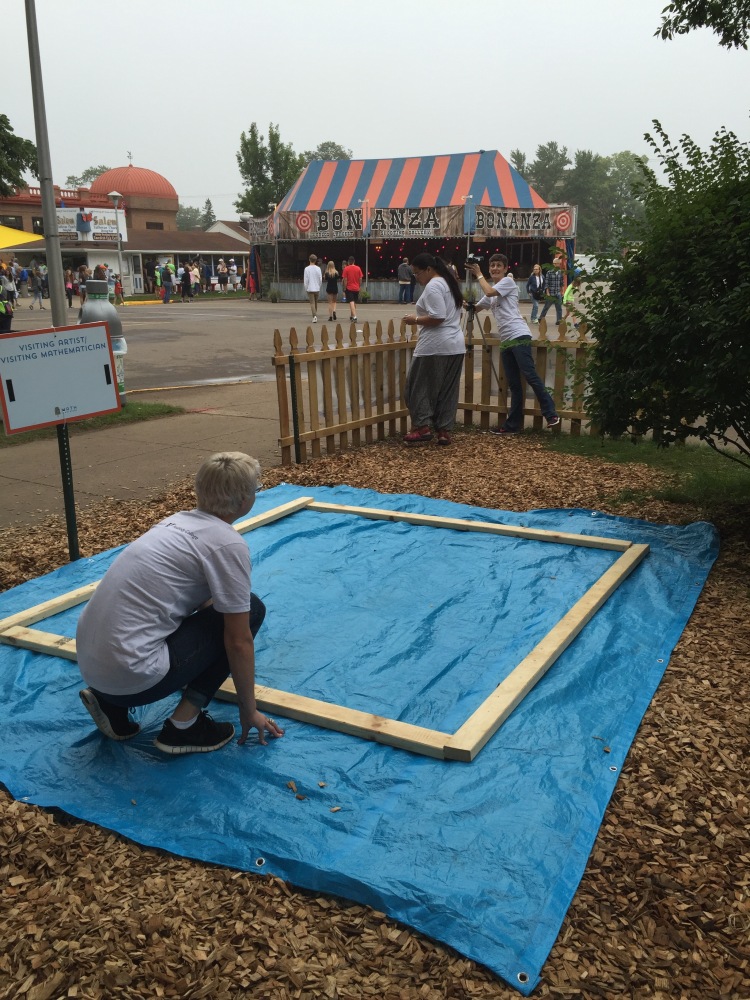I have had the great pleasure of spending the last several days at the Minnesota State Fair.

My colleague Melissa Gresalfi and I got a National Science Foundation grant to study a very special exhibit there called Math On-A-Stick. We have an awesome team of graduate students helping us with the research. They are Lara Heiberger, Panchompoo Fai Wisittanawat, Kate Chapman, and Amanda Bell.

Math On-A-Stick is the brainchild of Christopher Danielson, educator, promoter of talking math with your kids, and mathematical toy maker.

That is Christopher on the right. The woman in the pink jacket is a former math teacher. She made the beautiful quilt for Math On-A-Stick.
On the left is a tile station. The tiles are half black, half colored, and children can make all kinds of patterns with them. The center image comes from the pentagon station. I could spend all day there myself. I made that creation. On the right are tessalating lizards and turtles.
Everyday there are visiting mathematicians and mathematical artists. The first day I was there, Megan Schmidt brought some of her spiral magic. Yesterday were hexaflexagons.
Today, Christopher was the Visiting Mathematician. He built a giant pattern machine that children could play with. It is made up of little “pattern machines,” and the buttons pop up and down, making a satisfying clicking noise.
Melissa and I are interested in studying two things about children’s encounters with the exhibit. First, we are interested in the design, investigating how the various activities support mathematical interactions between children, the exhibit, the mathematics educators, parents –– and each other. Second, we are interested in children’s engagement. We want to examine how the children engage with different parts of the exhibit, looking for relationships among children’s ideas about mathematics, reported experiences in math class, and the exhibit design.
Our primary data come from recordings the kids make while they are playing. We outfit them with GoPro cameras so we can see how they interact with the exhibit, recording their interactions, their general gaze, and the time they spend at the various stations.

Melissa and Fai set up a stationary camera, while Lara pretends to be a kid at play.

A couple of kids getting outfitted with GoPros

Data collection station. It’s a well oiled machine.
Our research findings will help us identify more ways to make mathematics play a part of instruction. Already, many children are telling us that Math On-A-Stick math is different than what they do in school –– even kids who are inventing and problem solving in impressive and novel ways. We are looking forward to analyzing the hundreds of hours of data we collect and sharing what we learn with all of you.





Ilana, Thanks to you and your team for investigating Christopher’s exhibit at the fair. There is some fantastic math learning going on because of Christopher’s brilliance. A key to this is play and curiosity.
Cary Komoto, Dean of STEM & Education, Normandale Community College
LikeLike
Interested in the data and outcome of your study.
LikeLike
Me too!! The data already look amazing.
LikeLike
I love this idea! I have even participated in a math day camp for middle and high schoolers where we introduced students to higher level mathematics using fun games and activities such as number theory and graph theory using cryptology and biology respectively. The links in this post are really interesting as well and gives a great insight to what students were actually learning. I’m wondering though if you go through any math content after the game is over–kind of where you explain or explore the math behind the game or activity. Or is the main idea to encourage student problem solving in mathematical ways?
LikeLike
Thanks for the comment. The idea is to give kids a chance to play with these mathematically rich objects. Most of the time they explore the material. Other times they get really involved and start asking “what if…?” We see a lot of mathematical thinking that is less common in classrooms: conjecturing, making use of structure, extending an idea. These are mathematical ways of thinking, even if they are not formalized. Formalization is not the goal.
LikeLike
Hello, Ilana! My name is Andrew Cheun, and I am a senior at the University of Illinois at Urbana-Champaign studying mathematics with a minor in secondary education. This is such a great event! I’ve never heard of a state fair that had a ton of different math puzzles and activities! Back on campus, our methods class actually hosts a math event at a local high school, and we come up with different challenges for the students to try and accomplish, alongside with a set of games and puzzles. I’m curious, just as Amy posted, what the data looks like from the childrens’ engagement in the different activites at the fair, reason being that some students that aren’t used to applying mathematics to real-life puzzles might become easily frustrated and give up, similarly with their school work (just a possibility). On the flipside, it would be great if students became excited about these challenges, and brought it back to their schools and shared with their friends what it was like. I can’t wait to see what the results show, and for future blog posts!
LikeLike
One of our interview questions to our participants was, “Did anything frustrate you?” We haven’t yet analyzed the data, but based on our conversations, frustration was generally low and easily resolved. (Except for the one kid who answered: “Yeah. My brother and sister.” We can’t really help there.)
LikeLike
Pingback: Making Sense of Logarithms / Global Math Department